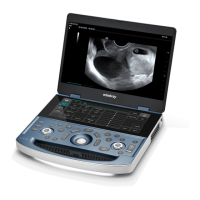6 Image Acquisition
Operator’s Manual 6 - 27
– Deleting data: select RIMT data from the data sheet. Tap [Delete Rows] to remove the
RIMT data of the left and the right carotid.
– Viewing graphic: tap [IMT Trend] to view the RIMT graphic. The data on the graphic is
same with these in data list. The RIMT average value, SD and ROI length of the exams
are displayed at the bottom of the graphic (including the current exam).
– Previewing the report: tap [Preview] to show IMT. The RIMT average value, SD and ROI
length of the exams are displayed.
See Advanced Volume for the settings, print, saving or loading the report.
6. Tap again [RIMT] to exit.
6.15 Tissue Tracking Quantitative Analysis
Tissue Tracking Quantitative Analysis images are provided for reference only,
not for confirming diagnoses.
Apart from TDI imaging function, the system also provides tissue tracking QA function for
myocardial movement evaluation.
By tissue tracking QA function, the ultrasound system will scan each pixel position by frame within
the cardiac cycle, and then use region matching method and auto-correlation searching method to
trace each spot and calculate the movement, so as to determine myocardial motion in a more
quantitative way.
Tissue tracking quantitative analysis is an option.
Only use the probes that support stress echo function under the cardiac mode to start Tissue
Tracking QA function.
6.15.1 Basic Procedures for Tissue Tracking QA
Perform the following procedure:
1. Open a saved B mode cardiac cine file.
A cin. format file which contains more than 1 cardiac cycle (with 2 R waves) and ECG signal.
2. Tap [Tissue Tracking QA] or press the user-defined key to activate the function:
– You can determine the image of interest by previewing the image.
– Use [Cycle] to select and find the image of interest.
3. Select the corresponding section name and locate one frame image with good image effect by
cine play. Use the cursor to set the reference point:
– Long axis section: use the “3-point” method or “Manual” method to set.
– Short axis section: enter multiple points (at least 6 points) using the cursor manually to
set.
4. After reference points are set, the system will display the boundary of the endocardium and
epicardium. Adjust the thickness if necessary.
If the traced result is poor, tap [Reload] to re-trace the reference points, or make fine
adjustments to the points using the cursor.

